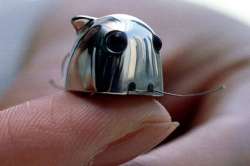Never failing to surprise us with creations beyond our imagination, technology has indeed come a long way.
In their continuous quest for innovation, scientists have now created soft, remote-controlled microrobots which can be used for several medical functions.
From delivering drugs at specific locations to performing precise operations like clearing clogged-up arteries, these newly designed robots can turn out be real handy.
Researchers around the world have been studying ways to use miniature robots designed to enter the human body to better treat a variety of diseases.
By replacing invasive, often complicated surgery, they could optimise medicine.
Scientists from EPFL (Ecole Polytechnique Federale de Lausanne) and ETH Zurich in Switzerland developed a simple and versatile method for building such bio-inspired robots and equipping them with advanced features.
They also created a platform for testing several robot designs and studying different modes of locomotion.
Their work produced complex reconfigurable microrobots that can be manufactured with high throughput.
They built an integrated manipulation platform that can remotely control the robots' mobility with electromagnetic fields, and cause them to shape-shift using heat.
Unlike conventional robots, these microrobots are soft, flexible, and motor-less. They are made of a biocompatible hydrogel and magnetic nanoparticles.
These nanoparticles give the microrobots their shape during the manufacturing process, and make them move and swim when an electromagnetic field is applied.
Building one of these microrobots involves several steps. First, the nanoparticles are placed inside layers of a biocompatible hydrogel.
Then an electromagnetic field is applied to orientate the nanoparticles at different parts of the robot, followed by a polymerisation step to "solidify" the hydrogel.
After this, the robot is placed in water where it folds in specific ways depending on the orientation of nanoparticles inside the gel, to form the final overall 3D architecture of the microrobot.
Once the final shape is achieved, an electromagnetic field is used to make the robot swim. Then, when heated, the robot changes shape and "unfolds".
This fabrication approach allowed the researchers to build microrobots that mimic the bacterium that causes African trypanosomiasis, otherwise known as sleeping sickness.
This particular bacterium uses a flagellum for propulsion, but hides it away once inside a person's bloodstream as a survival mechanism.
The researchers tested different microrobot designs to come up with one that imitates this behaviour. The prototype robot presented in this work has a bacterium-like flagellum that enables it to swim.
When heated with a laser, the flagellum wraps around the robot's body and is "hidden".
"Our new production method lets us test an array of shapes and combinations to obtain the best motion capability for a given task," said Selman Sakar from EPFL.
The study was published in the journal Nature Communications.
(With PTI inputs)
Latest Business News
